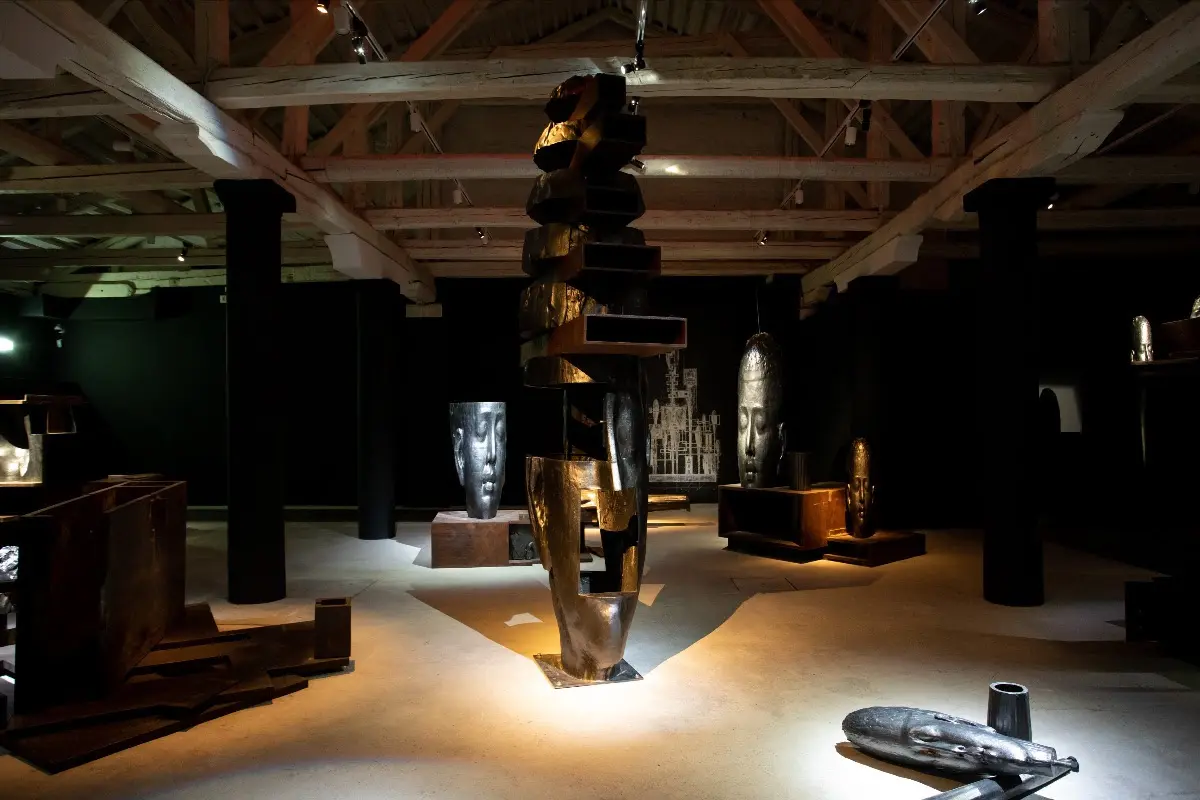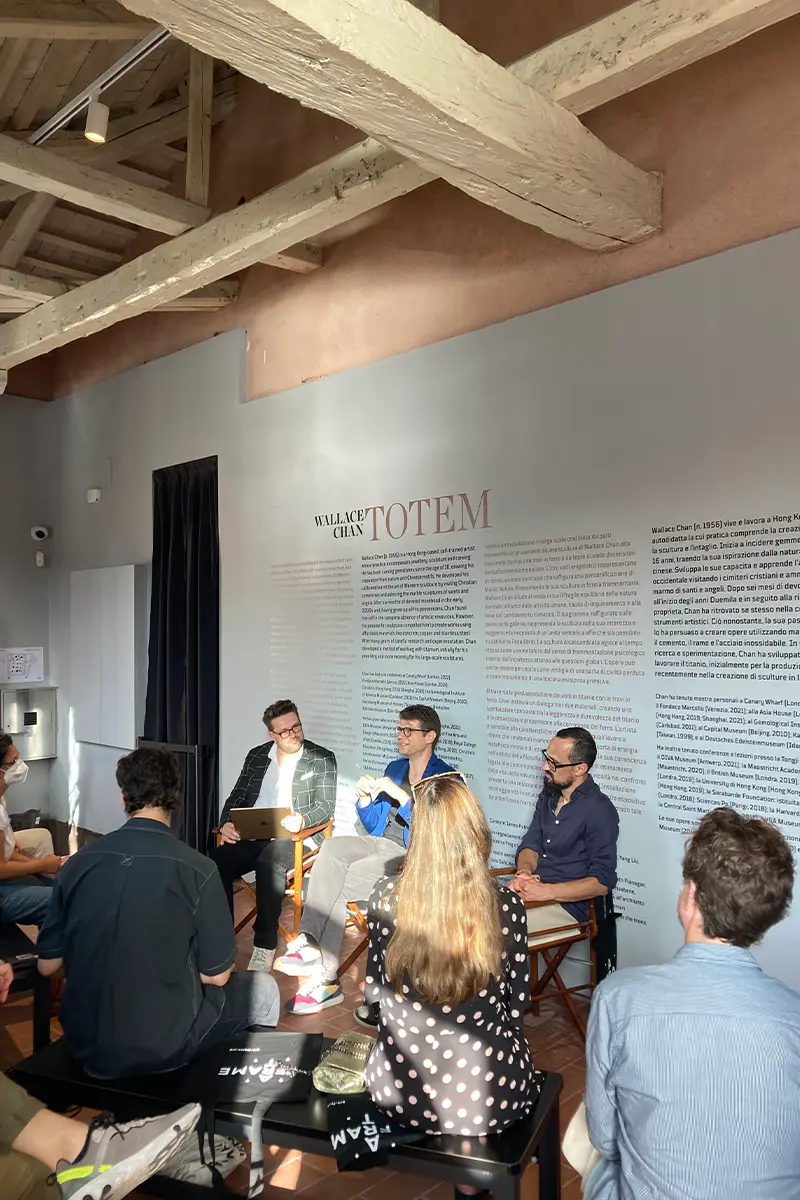Is the crypto crisis affecting NFT? Some see them as evil and some as the future of art. A model to be analyzed, to offer new perspectives
Lampoon reporting: the crypto crisis
Starting from summer 2022, the Cryptocurrency market has been facing the most severe crisis so far. With Bitcoin, currency par excellence, losing sixty percent of its value in the past six months. Last week, bankruptcy of tech giant and crypto exchange platform FTX pushed the markets into further chaos.
As a consequence, NFTs were also affected. With a ninety-eight percent fall in value. Yet, some experts remain confident. Oscar Franklin Tan, founder of NFT platform Enjin
A conversation about NFTs: meanings for the future of art
To gain a better understanding of what the phenomenon of NFTs means for the art world, in June 2022, Lampoon took part in a talk at Fondaco Marcello, Venice, organized by Art-Frame in collaboration with TOTEM by Wallace Chan. Artist Herwig Egon Casadoro-Kopp (HECK), crypto artist Mattia Cuttini and MoCDA art director and curator Filippo Lorenzin discussed the impact NFTs have had and might have on the art scene and its future. NFTs may well be the beginning or something new, the end of art as we know it, or both.
NFT: definition, technology, impact
On the topic, HECK reports, the traditional fine art market is divided. Starting from the basics: NFTs are different from cryptocurrencies, although they are both based on blockchain technology. The acronym itself (NFT) means Non -Fungible Tokens. This is also the main difference with currencies: «one token is not equal to another». Which is not true for cryptocurrencies: «you can exchange one bitcoin with another bitcoin just in the same way as you could swap one euro for another without causing any difference: the value is the same».
When it comes to NFTs, «much like artworks, tokens are not intrinsically interchangeable»: you could not exchange one painting with another just because they have the same price or dimension. The value lies elsewhere: in the art. Digital coins are a kind of money, tokens represent something that can be bought with money, and therefore owned. This is the point: NFT «is the quintessential symbol of what owning means». The job of Blockchain in this context is to keep track of what happens in a transparent way. According to Lorenzin, «you can use it just like a canvas. NFT is a technology, a tool to make art».
NFT and the art market
People started talking about NFT in relation to the traditional art market when the artwork Everydays: The First 5000 Days by crypto artist Beeple / aka Mike Winkelmann sold for sixty-nine million dollars. «That NFT contained a lot of artworks», explains Cuttini. It was five thousand artworks made in five thousand days, «detailed, polemic, political». At that point, artists and experts in the industry began to consider the possibility that NFT could create a new art movement. Though, as Lorenzin points out, «there are not many art movements that were born because one guy sold an artwork for a lot of money».
Unexplored new possibilities: in the making
NFT seems to offer a range of new concepts, as well as widening the scope of the art field. Opening it up to more artists. «Most people who are selling NFTs have a background in graphic design, 3D modeling – so called apply arts», Lorenzin notes, and «they have not been present in the fine art conversation so far». A change could come: «the most interesting part of this technology is that a group of people who worked for many years as illustrators or designers finally found a way of being independent and have the tools to do it». This is also about economics. NFT allows for a valued source of income. Art takes time, which is not always valued in terms of money.
Updated institution: the Museum of Contemporary Digital Art
The Museum of Contemporary Digital Art was funded with the aim of displaying digital art within its own context. As its website reads, MoCDA «provides digital art education and technology to artists, collectors, institutions and art lovers. First and foremost, MoCDA is a museum that exhibits digital artworks for the purpose of documenting, collecting and advancing the position of digital art. MoCDA provides a foundation for understanding digital art in its own context, rather than as a mere by-product of the larger art world».
Museum decentralization
Lorenzin, art director and curator of the institution explains that MoCDA is a decentralized institution: «we do not have a physical place to present our collection». To design and showcase the exhibition they use «several metaverses». The term metaverse, first coined in 1992 by science fiction author Neal Stephenson, refers to a digital three-dimensional space where human avatars and software agents interact. Popular video games like Farmville or The Sims can be considered an early metaverse version.
«We will open an exhibition developed with fifteen art schools and art universities from around the word» Lorenzin told Lampoon. Thanks to technology like the metaverse, «we have had the opportunity to meet all these students». It may be the first time an art movement develops without physical proximity being a limit. The only limit is the willingness to participate and availability of the technology. Times change and institutions must adapt, to be able to showcase all forms of art.
Discussing NFTs: social impact
The relationship between artwork and artist is also changing. NFTs have the potential to «be a game-changer also on a social level» according to Cuttini: «behind a nickname you can be black, white, blue, male, female or something in between». This is the vision: to guarantee «true diversity: people only judge the art, without knowing who is behind it». As Barthes would put it, we could be witnessing the actual Death of the Author. The issue could become a digital divide: the technological assets you need in order to create and consume digital art.
Crypto and NFTs: what it is to artists
According to Cuttini, who creates both crypto and physical artworks, «being an artist in this moment in this space represents a way to make money out of my art» among other stimulating aspects. The NFT market is linked to the cryptocurrencies value, which in turn affects the income of artists. When the cryptocurrencies market experiences falls, NFTs are likely to lose value as well. According to Lorenzin, though, «the revolutionary aspect was not just about the amount of money you could get out of it, but the unity of people coming together – that was the real game changer – that is something it is going to remain» regardless of the fate of cryptocurrencies. It is about choices: «if it is an art movement, it cannot just be tight to the value – otherwise it is just an economical event».
State of the market: from injection to crisis
«What happens now» explains Lorenzin, «is a little like what happens in cities with gentrification»: once a phenomenon – or a neighborhood, in the case of gentrification – that used to be uninteresting, attracts attention and proves to be profitable, big capitals rush into it. Which is why NFT, and the crypto market, have experienced a constant injection of liquidity. Now, with recession, a pandemic and the war so close to Europe, the market is slowing down. It may be the time for the true identifying feature of NFT to be valued: decentralization.
Decentralization: the core of it all
The digital age can be tricky for artists, even if fame seems easier to reach. It all depends on the platforms they choose to trust. Many opt for platforms like Instagram. But what if Meta fails? For artists, it would mean losing works, but especially fame and reputation, often built on social media profiles. By contrast, «a decentralized approach allows artists to own their artworks and have them handy even if platforms shut down», HECK argues.
«The internet was meant like a decentralized approach for communication», but what came out of it is not decentralized: powers, mainly economic ones, took over again: «for some reason it makes sense to put some kind of power in – which is a threat to the overall promise of making it decentralized». Decentralization in art also means control: artists can access information about who saw their work, when, and where. With social media, this is harder to determine with precision. With social media, says Cuttini, «all you get is likes». Which only has a meaning because platforms invented it. Some say it is the end of culture but, HECK argues, «every time in art history someone claimed that something would be the end of culture, something interesting came out of it».
Analogue and NFT: not a contradiction
Cuttini creates both physical and digital artworks: «I need not be on my computer all the time to be able to create». Creativity comes in: «I invent new ways to create analogue art to stay away from the computer – like a spiritual aspect». He managed to «use the same tools to create real-life pixel art and then found a way to link the physical artwork to the NFT». Which is the most fascinating aspect: «The two have different behaviors». Over time, the digital does not degrade, while the physical does. Which creates a whole different kind of art: one of its own.
HECK: showcasing paradox
The artist himself is torn. HECK has created one physical artwork and a very limited edition of one virtual artwork titled IAMATOKEN. It is however not for sale, pointing at the paradox that lies within the system. The description reads: «I am not a token. This is a picture. This is not me. Being a unique picture is not important. I am genetic code, a menace to the ecosystem. Commodifying life & the planet equals destruction. I am not an asset. I am a non-fungible token not for sale. I am a white, grateful artist – lucky, privileged and full of proof of work».
Environmental impact
NFTs belong to the realm of the digital, but they are not abstract beings: they have concrete impacts on the environment. Although NFTs themselves do not produce any Carbon emissions, the way they are produced does. A study by Digiconomist – a platform that is dedicated to exposing the unintended consequences of digital trends – found that «A single NFT transaction on the Ethereum platform emits almost 0.02 kilograms of carbon dioxide, equivalent to 44 Visa transactions or 3 hours of watching YouTube».
This depends on many factors, starting from whether NFTs are ‘minted’ through blockchain technology using proof-of-work or proof-of-stake. Since concerns were risen, however, the industry adapted: off-setting, encouraging the use of proof-of-stake (which consumes less energy), and power it with renewables, are just some of the solutions the crypto-art industry is resorting to, in order to make its future greener.
Filippo Lorenzin
With more than 10 years of first-hand experience in contemporary art, digital culture and education, FILIPPO LORENZIN collaborated with major international cultural institutions, including Victoria and Albert Museum, Goethe Institut and Paris College of Art. He is currently the Artistic Director of MoCDA – Museum of Contemporary Digital Art.
HECK
New Yorker Pop-Art-artists and his artwork attracts interest in the US as well as in Europe. In 1963 he was born in Brooklyn and he still lives there today.
Mattia Cuttini
Italian artist whose interdisciplinary practice is situated at the intersection of graphic design and blockchain technology. Cuttini pursued his education in technology, and later reinvented himself as an artist, using several mediums beyond visual including music and performance art.




















